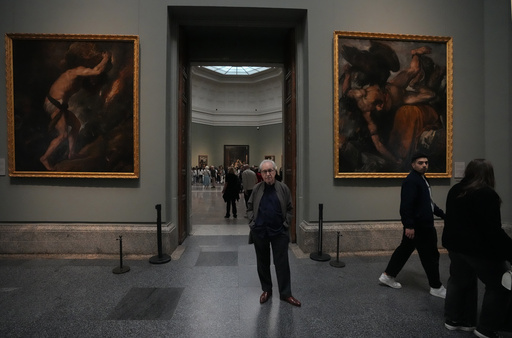
MADRID — Acclaimed Irish novelist John Banville finds himself captivated by the expressive eyes of artworks at the Prado Museum, which he believes blur the lines between art and reality. Despite having the privilege to explore the museum at any hour due to a month-long literary fellowship, Banville prefers the bustling daytime atmosphere, as he feels uncomfortable alone among the silent spectators on the walls. “I don’t like coming here after hours, it’s too eerie. The pictures, they look at you,” he remarked, glancing away from Diego Velázquez’s iconic painting, “Las Meninas,” which attracts countless admirers.
In this monumental 17th-century piece, the Infanta Margarita stands at the center, surrounded by her ladies-in-waiting, a dwarf, a buffoon with a dog, a nun, and a mysterious man heading through an unseen door, along with a mirror that reflects King Philip IV and his queen. Velázquez also steps back into the scene, making eye contact with viewers and inviting them to ponder his artistic mastery. This masterpiece of Baroque elegance has intrigued many artists, including Banville, who cherishes its complex beauty. “I find that ‘Las Meninas’ is always a surprise to me, and a challenge. It’s the enigma of it, the strangeness of it. Every time I look at it, it becomes stranger again,” he explained, as visitors moved around him. He expressed that Velázquez seems to challenge onlookers: “Look what I did. Would you have been able to do anything like this?”
As part of the “Writing the Prado” initiative, supported by the Loewe Foundation, Banville has been granted exceptional access to various parts of the museum, including closed-off areas such as restoration workshops. This fellowship program, which commenced last year, has also included distinguished writers such as Nobel laureates John Coetzee and Olga Tokarczuk, along with Mexican American author Chloe Aridjis. The fellows immerse themselves in the museum’s environment for a month, eventually producing a short piece of fiction that is later published by the museum with the help of Granta en español magazine. Although Banville has not fully determined the plot of his story, he plans to center it around the experience of a visitor navigating the gallery and the haunting presence of the artworks’ eyes. “The eyes follow him. And I think … all his life … he’d had the fear of being found out, and all these eyes seem to know it. And I think Velázquez says ‘Yeah, I know who you are,’” he mused.
Banville has long held a fascination with visual art, which began as a young man who once contemplated becoming a painter. However, he attributes his turn to writing to an inability to master artistic techniques. “I couldn’t draw, had no sense of color, no grasp of draftsmanship. These are distinct disadvantages if you want to be a painter,” he admitted, humorously reflecting on his past failures as an artist. “I painted some dreadful pictures, oh God. If they ever come out I am doomed.” From that moment, he embraced writing as his form of expression.
The Prado Museum attracted over 3.2 million visitors last year, eager to witness Spain’s rich artistic heritage. The esteemed collection features over 4,000 pieces, showcasing notable works by masters such as Velázquez, Rubens, Bosch, Goya, El Greco, and Titian, among others. The museum, however, has a strict no-photo policy, which Banville believes creates a more immersive experience. “It’s wonderful. I see people going around other galleries just taking photos, and I want to say to them, ‘look at the bloody picture’!” he declared, advocating for similar rules in museums worldwide.
While he finds Goya’s “Black Paintings” somewhat excessive, he is enamored by Rubens’ representation of love, humorously commenting that the women depicted appear “made of bread dough.” He is also drawn to Velázquez’s “The Feast of Bacchus,” where the wine god revels with drunken companions, drawing a parallel with his own experience in Madrid. This fellowship period has granted Banville a rare month off from his usual writing routine, which he estimates to have begun at age 12. “This little voice inside of me said ‘John, take the month off. Just enjoy,’” he recalled, while enjoying the sunny weather and a glass of wine, fondly aware of the dreary conditions back home in Ireland.
At 78 years old and having lost his wife three years ago, Banville contemplates his future as an author. However, he remains untroubled by the rise of artificial intelligence in the creative sphere. “A work of art is a very rare thing. There are attempts at works of art, and there are people who imagine that they’ve made a work of art, but they’re just kitsch. Real art won’t succumb to AI,” he asserted confidently. “I find works of art to be alive.”
